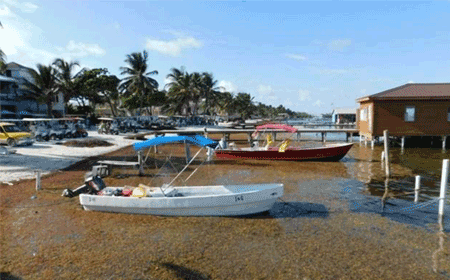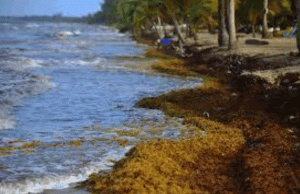BELIZE CITY, Thurs. June 20, 2019– For years, Central America and the Caribbean have been plagued by the presence of the dreaded Sargassum. This brown algae first started affecting Belize on the coast of San Pedro, creating a foul odor as it accumulates and rots at the water’s edge.
Since as far back as 2015, reports have made it to the public about the Sargassum’s rapid spread to other areas such as Caye Caulker, Hopkins and Placencia. In neighboring countries the phenomenon has grown to alarming levels and destinations such Quintana Roo have even declared the situation to be an imminent natural disaster.
The main concern regarding the continuous spread of the algae is the potential effects it may have on Belize’s tourism industry. Despite there not being a confirmed, quantified impact on tourism arrivals and length of stay as a result of the presence of Sargassum, it is still a concern that eventually it may become too much for visitors who come to Belize to enjoy clean beaches and crystalline waters.
Cabinet has taken into consideration the potential threats to hoteliers with sea-front properties and even introduced some relief measures, such as the 4-month hotel tax relief for all beach-front hoteliers, which took effect at the end of 2018.
Other initiatives such as the ongoing beach cleanup projects have been implemented in various tourist hotspots and the government has designated over $1 million to aid these projects. There have even been tariff (duty) exemptions approved by Cabinet for all equipment being imported for Sargassum clean-up and reduction initiatives.
Collectively, these assistance measures by the government have benefited hundreds of property owners in the affected areas. There are other entities as well which have made contributions to contain the spread of the Sargassum such as the Sargassum Task Force, NEMO, BTB and even the National Meteorological Service of Belize.
The task force is trying to incorporate technology in their fight against Sargassum, and have provided small insights on their intentions to stage a Boom Installation Pilot Test in San Pedro to see if this would be effective in reducing the effects of the Sargassum.
A containment boom is a temporary floating barrier normally used to contain an oil spill, which protects shorelines from pollution. The Sargassum Task Force, in collaboration with the National Met Services and the Department of Civil Aviation, is tasked to study the drift patterns of the Sargassum in order to create a forecasting system in Belize.
Reports are currently being disseminated every Wednesday to Friday during the local weather forecast on the news. Further development of this project could lead to Belize being the first nation in this region to have a local Sargassum forecasting system.
The abundance of the algae has negative effects on both aquatic animals and plants. The death of fish has been noticed on the beaches of San Pedro, caused by the reduction of oxygen levels due to the bacteria that decompose the Sargassum in the water.
There is also a reduction of sunlight penetrating the water due to the canopy that these blankets of Sargassum cause, affecting the process of photosynthesis for aquatic plants and coral. Apart from this, Sargassum has been known to cause a foul odor and skin irritations when one becomes directly exposed to it.


